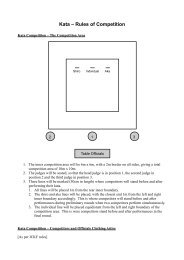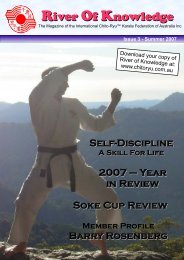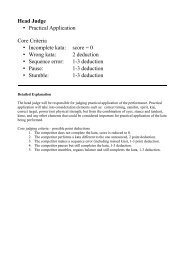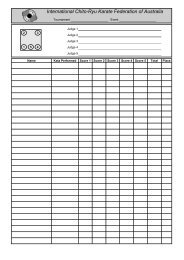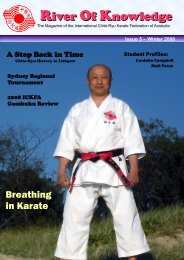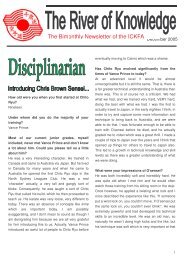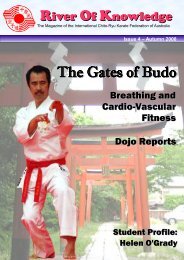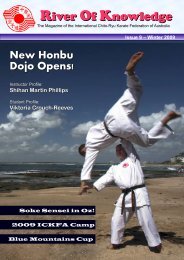River of Knowledge - International Chito-Ryu Karate-do Federation ...
River of Knowledge - International Chito-Ryu Karate-do Federation ...
River of Knowledge - International Chito-Ryu Karate-do Federation ...
- No tags were found...
You also want an ePaper? Increase the reach of your titles
YUMPU automatically turns print PDFs into web optimized ePapers that Google loves.
<strong>Chito</strong>-<strong>Ryu</strong> Historymuch as the person who has <strong>do</strong>ne it. That is why, when you take up your position on the karatetraining deck, you forget who you are in life and think only <strong>of</strong> what and who you are in karate.ACCEPTING THE SYSTEMS OF TESTThe reason for the physical test that each beginner must undergo is that each one must beclassed according to his merits. He must be able to overcome certain obstacles before he can moveon to the next grade. But what makes these tests different from the usual ones is that test both thetechniques and the mental attitude <strong>of</strong> the karate student. Never forget, by the way, that some <strong>of</strong> thetests are painful and demand quite a lot <strong>of</strong> courage.Tests set by the instructor vary according to each karate school and its particular customs.Page 3They may be real tests or just simple reviews, sessions with various endurance tests also have to bepassed. The art <strong>of</strong> the instructor lies in knowing what test to set for a certain student and in what circumstances. If thetest is too easy, it will be impossible to see how the karate student behaves under strain. On the other hand if the test isto hard it runs the risk <strong>of</strong> discouraging the karate student or exhausting him and making him give up <strong>Karate</strong>.THE RITUAL OF THE KARATE SCHOOLThis is one <strong>of</strong> the ways in which the Oriental origins <strong>of</strong> <strong>Karate</strong> may be seen most clearly. This ritual, which iscommon to all Japanese warlike sports (Ju<strong>do</strong>, Aiki<strong>do</strong>, <strong>Karate</strong> and Ken<strong>do</strong>) is the outward sign <strong>of</strong> the traditional goodmanners <strong>of</strong> the Oriental. With its solemnity, it is a valuable means in “Orientalising” the student, and this ritual is a part <strong>of</strong>every training session in the <strong>do</strong>jo.In the karate school there is an atmosphere <strong>of</strong> meditation. When you go in your mind cannot help but turn tonoble thoughts.THE GREETINGSRitual in the karate school includes numerous greetings, which, although they may look outwardly alike, <strong>do</strong> not allhave the same significance.GREETING THE KARATE TRAINING DECKThis is the first greeting made when you have put on your karate uniform and go into the main training room. Youbow as get onto the training deck. You immediately stop, place your two feet together, and greet the premises, rather inthe way that an actor acknowledges the audience at the end <strong>of</strong> a play, by bowing slightly from the waist and bending thehead.This greeting has a precise meaning. It may be translated as follows. “I realize that I am now standing on thetraining deck <strong>of</strong> the karate school. By bowing my head, I show my respect for all the traditional rules which I undertake torespect all the time I stay on this training area.” This greeting is directed at the training area itself, that is to say, at thepremises, and <strong>do</strong>es not refer in any way to the people present. It follows that the ceremony takes place even if there isnobody present, neither on the training area or in the karate school.GREETING THE INSTRUCTORThe aim <strong>of</strong> this is to show the respect you have for your instructor and his assistant instructors who representhim.This greeting is only made in the presence <strong>of</strong> the instructor. The students line up facing him, go <strong>do</strong>wn on theirknees, and squat on their heels. Then, when the instructor himself has taken up this traditional attitude, the bend forwarduntil their heads are touching the ground. The instructor then returns the greeting.It is good manners for the students to remain with heads bowed until the instructor has got up. Symbolically, thestudent should not hot see his instructor with head bowed.This greeting is the outward sign <strong>of</strong> thoughts such as these: “Dear Master, I am now in your hands. When I camein here, I left behind all my daily cares, and I am ready to receive your teachings and I hop that I may be worthy <strong>of</strong> them.”This thought is far from being a servile one, because when later on the <strong>Karate</strong>ka has developed into being acomplete man, in all senses <strong>of</strong> the term, he will owe everything to the training and teaching he received in the <strong>do</strong>jo.These respects which are paid to the instructor must take place at the beginning <strong>of</strong> each session at which the <strong>Karate</strong>kahas the good fortune to be present.GREETING YOUR PARTNERTo show your respect for the partner with whom you are going to train, you greet him as well, in a way similar tothat with which fencers greet each other.In the same way as you greeted the mat, you stand motionless, feet together, and you bow



